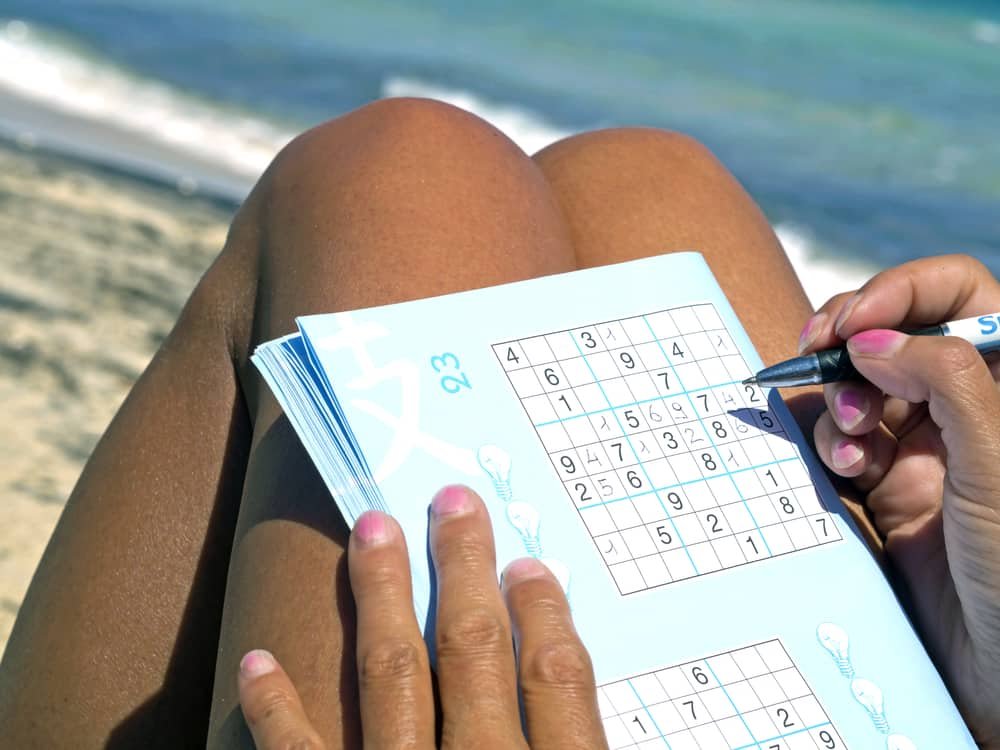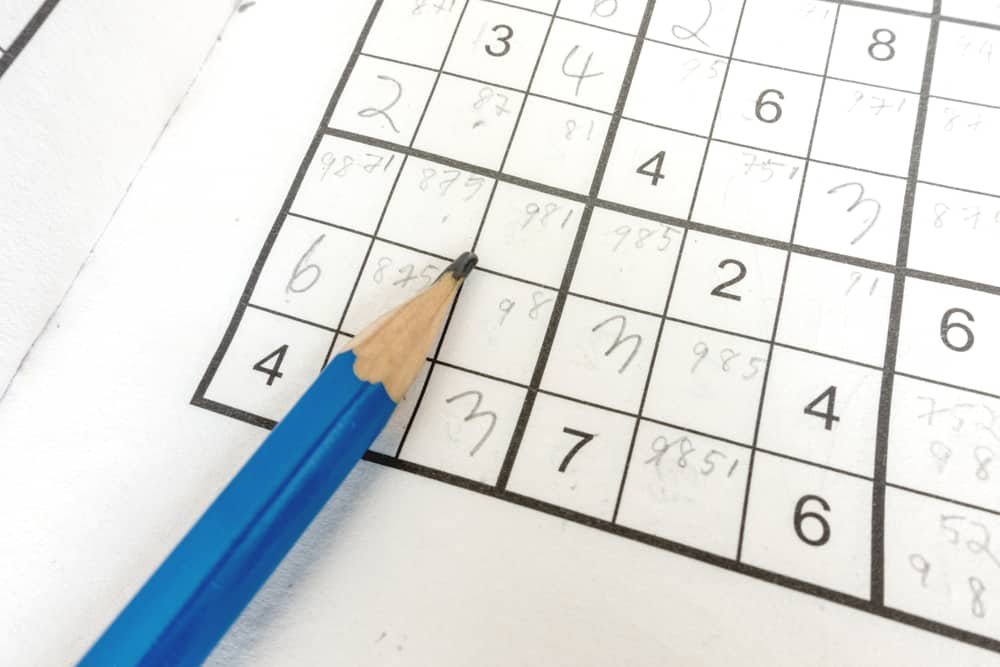Last Updated on January 7, 2024 by Gamesver Team and JC Franco

Sudoku has taken the world by storm, but there are still millions of people who do not know how to play the game. Are you one of those people or are you already an avid Sudoku player? If you play Sudoku regularly, you probably know about the rules. However, there are many people who do not consider Sudoku a viable pastime because they believe that it is a mathematics-based game.
While Sudoku is based on a concept invented by a Swiss mathematician, it requires no arithmetic knowledge and is purely a logic-based game. Anyone can play Sudoku, including you! Are you ready to learn the rules?
Sudoku rules for beginners
- Only use the numbers 1 to 9,
- Avoid trying to guess the solution to the puzzle,
- Only use each number once in each row, column, & grid,
- Use the process of elimination as a tactic,
- Use cross-hatching and penciling in techniques.
By following these simple rules, you should be able to work out the solution to just about any Sudoku puzzle that you encounter. If you find that a puzzle is proving impossible to solve; it is probably the difficulty level of the puzzle, that is the problem, and not because you are not following the rules correctly.
If you have not played Sudoku before, these rules probably do not mean much to you. They would make more sense with a bit more understanding of the objective of the game and more insight into each rule.
This article aims to provide beginner players with some valuable insight into the game rules, without getting too complicated.
The Objective of a Sudoku Game | Why Play the Game?

Before you can get started with Sudoku, you need to understand what the point is. Why are you playing the game? What is the expected outcome? There is always a reason for playing a game. For some games, the reason is to challenge other players and win. For other games, the purpose is to successfully solve a problem and keep improving your skills. The reason for playing Sudoku is the latter.
As a logic-based number-placement puzzle, the objective of the game is to solve the puzzle. The objective is: to complete a 9×9 grid by filling in missing digits from 1 to 9, without using the numbers more than once in each row, column and grid. For all intents and purposes, the game is one of organizing numbers in their rightful place. One only needs a keen eye and logical thinking to triumph.
Sudoku – The Rules (For Beginners)!
Those who haven’t played Sudoku before or are encountering it for the first time usually take a look at the game and think it is too complicated or difficult. It is really not. All you need to do is understand the rules and have the time to sit down with the puzzle.
Are you a bit shaky on the rules of Sudoku? Do not worry, they become easier to understand the more you play the game. In fact, if you have not played before, the best way to learn is to pick up a Sudoku puzzle and try to solve it, with these rules close at hand.
Below is an explanation of each of the abovementioned rules for Sudoku beginners.
1. Only use the numbers 1 to 9 in a game of Sudoku.

Why does a game of Sudoku only require the numbers 1 to 9? And why are they only used once?
Standard Sudoku games are played in grids with 9 blocks x 9 blocks. The columns and rows make up 9 squares that feature spaces of 3 x 3. Every single row, square, and column must be filled in with the numbers 1 to 9. The catch is that you can only use each number once – no numbers can be repeated in a row, column, or square. And that is where things become complicated!
Each Sudoku puzzle published already has a number of the blocks filled in, to make things a little simpler and to serve as clues for the final solution to the puzzle.
2. Avoid trying to guess the solution to the Sudoku puzzle.
It is tempting to try to guess the solution to a Sudoku puzzle when you are just starting out. For beginners (and pros), this is usually not a good idea. Sudoku is not a guessing game; therefore guessing shouldn’t form part of your game strategy . You might find that guessing only leads to wasting time.
What do you do if you can’t try to guess the numbers for each block then? You will need to use logic and reason to determine the answers – in fact, if you want to give your brain the workout that’s intended, you should only use logic and reason! Keep scanning the grid and sub-grids for possible placement of missing numbers. If you can’t figure out where to place numbers, move on to different section. Some Sudoku games present a pattern in the numbers, which can help you to decide where to put the missing numbers in the grid.
3. Only use each number once – do not repeat any numbers.

This is where things become a little trickier. You can only use each number once in each sub-grid row and column, as well as just once on the entire grid’s rows and columns. Is this possible? It actually is! To do this, you will need to note which numbers happen to be missing from each of the columns, rows, and blocks. Deductive reasoning and the process of elimination can be used to determine which missing numbers belong in which blocks on the grid.
Once you learn how to quickly scan the grids, columns, and rows, this will become a great deal easier.
4. Use the process of elimination as a tactic.
What about the tactics? What
The process of elimination is actually a great tactic as by knowing which numbers are already present, you can start to reason which numbers are missing and which best go into the open blocks. You could write the numbers 1-9 down and then cross off each one for each row until you know what is needed for each block. As you can only use each number once, it is not too hard to figure out which numbers are needed. After that, it is just a case of trying to figure out where each of the numbers belongs – they can’t just go anywhere.
5. Use cross-hatching and penciling-in techniques to solve the puzzle.
As a rule (or personal preference), players can make use of popular techniques for solving the Sudoku puzzle. Cross-hatching and penciling-in are popular techniques. How do you use them?

Cross-hatching is a technique whereby a player focuses on just one 3×3 grid/square at a time and tries to complete the open blocks using the rule that each number can only appear once. Then, each column and row is scanned while taking into account which numbers have been filled into the first 3×3 grid. If a misplaced number is spotted in the singular 3 x 3 grid, it is removed, and the process is started over.
Penciling-in is the process inserting all of the possible numbers into the open blocks in each nonet (this is a 3 x 3 grid). Once this is done, the process of cross-hatching is carried out as per normal while removing (scratching out) each of the incorrect or not-possible numbers. Many beginner Sudoku players find this an easy and rewarding technique.
Are the Rules of Sudoku the Same for All Difficulty Levels?
Newbies to the game of Sudoku sometimes wonder if the rules vary according to the difficulty level they are playing on. While there are different difficulty levels available for Sudoku, the rules remain the same for all.
The only time the rules change is when playing a version of Sudoku that deals with more blocks in the grid, such as:
- Mega Sudoku – in this case, the only rule change is that the game is played using the numbers 1 to 12 or 1 to 16.
- Mini Sudoku – in this case, the only rule change is that the game is played using the numbers 1 to 4 or 1 to 6.
That being said, for the most challenging and easiest Sudoku games in the world, the general rules are the same.

All things considered
As a beginner, you may find your first few attempts of Sudoku to be plagued with trial and error, but press on. Once you get the concept of the game and your brain starts to recognize patterns with ease, the game will become far easier (and as a result, the solutions far easier to come by).

